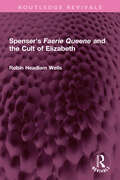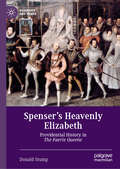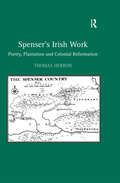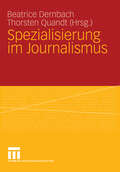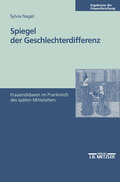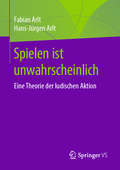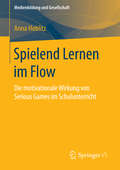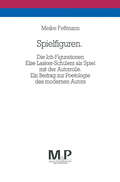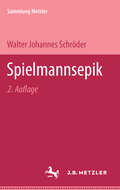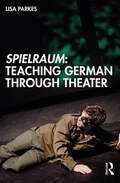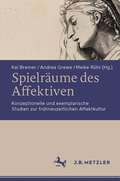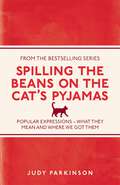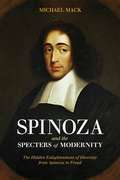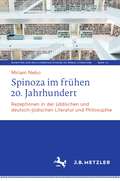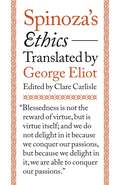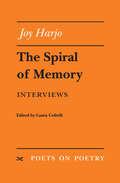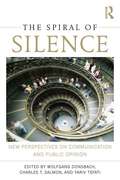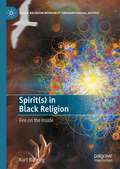- Table View
- List View
Spenser's Faerie Queene and the Cult of Elizabeth (Routledge Revivals)
by Robin Headlam WellsFirst published in 1983, Spenser’s Faerie Queene and the Cult of Elizabeth presents The Faerie Queene as a central document in the cult of Elizabeth. It shows how Spenser combines the resources of medieval iconography and Renaissance rhetoric in celebrating the Queen as the predestined ruler of an elect nation. In its introductory discussion of Renaissance poetics, the book emphasises the contemporary belief in the moral function of praise. Particular attention is given to the popular identification of Elizabeth with the Virgin Mary. If Elizabeth’s gender created problems for a poet writing in the heroic mode, at the same time it made available to him a form of praise that no secular poet had been able to use before. While the book contains material of interest to the Renaissance specialist, its lucid style and the valuable background material it provides will appeal to undergraduates reading Spenser for the first time.
Spenser's Faerie Queene and the Cult of Elizabeth (Routledge Revivals)
by Robin Headlam WellsFirst published in 1983, Spenser’s Faerie Queene and the Cult of Elizabeth presents The Faerie Queene as a central document in the cult of Elizabeth. It shows how Spenser combines the resources of medieval iconography and Renaissance rhetoric in celebrating the Queen as the predestined ruler of an elect nation. In its introductory discussion of Renaissance poetics, the book emphasises the contemporary belief in the moral function of praise. Particular attention is given to the popular identification of Elizabeth with the Virgin Mary. If Elizabeth’s gender created problems for a poet writing in the heroic mode, at the same time it made available to him a form of praise that no secular poet had been able to use before. While the book contains material of interest to the Renaissance specialist, its lucid style and the valuable background material it provides will appeal to undergraduates reading Spenser for the first time.
Spenser’s Heavenly Elizabeth: Providential History in The Faerie Queene (Queenship and Power)
by Donald StumpThis book reveals the queen behind Edmund Spenser’s The Faerie Queene. Placing Spenser’s epic poem in the context of the tumultuous sixteenth century, Donald Stump offers a groundbreaking reading of the poem as an allegory of Elizabeth I’s life. By narrating the loves and wars of an Arthurian realm that mirrors Elizabethan England, Spenser explores the crises that shaped Elizabeth’s reign: her break with the pope to create a reformed English Church, her standoff with Mary, Queen of Scots, offensives against Irish rebels and Spanish troops, confrontations with assassins and foreign invaders, and the apocalyptic expectations of the English people in a time of national transformation. Brilliantly reconciling moral and historicist readings, this volume offers a major new interpretation of The Faerie Queene.
Spenser's Irish Work: Poetry, Plantation and Colonial Reformation
by Thomas HerronExploring Edmund Spenser's writings within the historical and aesthetic context of colonial agricultural reform in Ireland, his adopted home, this study demonstrates how Irish events and influences operate in far more of Spenser's work than previously suspected. Thomas Herron explores Spenser's relation to contemporary English poets and polemicists in Munster, such as Sir Walter Raleigh, Ralph Birkenshaw and Parr Lane, as well as heretofore neglected Irish material in Elizabethan pageantry in the 1590s, such as the famously elaborate state performances at Elvetham and Rycote. New light is shed here on the Irish significance of both the earlier and later Books of The Fairie Queene. Herron examines in depth Spenser's adaptation of the paradigm of the laboring artist for empire found in Virgil's Georgics, which Herron weaves explicitly with Spenser's experience as an administrator, property owner and planter in Ireland. Taking in history, religion, geography, classics and colonial studies, as well as early modern literature and Irish studies, this book constitutes a valuable addition to Spenser scholarship.
Spenser's Irish Work: Poetry, Plantation and Colonial Reformation
by Thomas HerronExploring Edmund Spenser's writings within the historical and aesthetic context of colonial agricultural reform in Ireland, his adopted home, this study demonstrates how Irish events and influences operate in far more of Spenser's work than previously suspected. Thomas Herron explores Spenser's relation to contemporary English poets and polemicists in Munster, such as Sir Walter Raleigh, Ralph Birkenshaw and Parr Lane, as well as heretofore neglected Irish material in Elizabethan pageantry in the 1590s, such as the famously elaborate state performances at Elvetham and Rycote. New light is shed here on the Irish significance of both the earlier and later Books of The Fairie Queene. Herron examines in depth Spenser's adaptation of the paradigm of the laboring artist for empire found in Virgil's Georgics, which Herron weaves explicitly with Spenser's experience as an administrator, property owner and planter in Ireland. Taking in history, religion, geography, classics and colonial studies, as well as early modern literature and Irish studies, this book constitutes a valuable addition to Spenser scholarship.
Spezialisierung im Journalismus
by Beatrice Dernbach Thorsten QuandtAuf die immer stärkere Ausdifferenzierung des Publikums in kleinere und kleinste Interessengruppen reagiert der Journalismus mit einer zunehmenden Spezialisierung: Nahezu jedes vermutete oder offenkundige Publikumsinteresse wird mit publizistischen Angeboten in jeder denkbaren Form bedient. So findet man im Printbereich neben klassischen Allround-Titeln für Wirtschaft, Sport, Politik und Kultur auch Very-special-interest- und Fach-Publikationen für den Geldanleger, den Jazzliebhaber, den Segler, den Angler, den Uhrenfan. Im Internet boomen immer spezialisiertere Webseiten und Blogs. Und auch das Fernsehen entdeckt zunehmend kleinere Nischen und Sparten. Mit den positiven wie negativen Aspekten dieser Spezialisierung setzt sich der vorliegende Sammelband sowohl aus wissenschaftlicher als auch aus praxis-bezogener Sichtweise auseinander.
Spiegel der Geschlechterdifferenz: Frauendidaxen im Frankreich des späten Mittelalters (Ergebnisse der Frauenforschung)
by Sylvia NagelReden und Schreiben sind nicht geschlechtsneutral, sondern reflektieren geschlechtsspezifische Erfahrungen und Vorstellungen. Bereits in Frauendidaxen des 14. und 15. Jahrhunderts ist die Differenz der Geschlechter Bestandteil der Anweisungen. Untersucht werden drei zeitnah entstandene Werke, mit vergleichbaren standes- und geschlechtstypischen Ratschlägen für Frauen. Der Livre du Chevalier de la Tour Laundry und der Menagier de Paris wurden von Männern verfasst. Sie konzentrieren sich auf die für den adligen und bürgerlichen Stand relevanten christlichen Tugenden und dem Gehorsam gegenüber dem Ehemann. Christine de Pizan wendet sich in ihrem Livre des Trois Vertus an Adressatinnen aus allen Ständen. Ihr geht es darum, ihre Leserinnen für alle Lebensbereiche kompetent zu machen. Sylvia Nagel erarbeitet die Interdependenz der in den drei Texten erkennbaren männlich dominanten und weiblich unterdrückten Kultur und deren Ausprägungen als kulturelle und soziale Erscheinungen. Es zeigt sich, dass Christine de Pizan mit ihren Vorstellungen von weiblichen Tätigkeitsfeldern und den Handlungs- und Sprachmöglichkeiten von Frauen eine herausragende Stellung in der didaktischen französischen Literatur einnimmt.
Spielen ist unwahrscheinlich: Eine Theorie der ludischen Aktion
by Fabian Arlt Hans-Jürgen ArltBegründet und entfaltet wird ein Begriff des Spiels, der sich um Lockungen und Drohungen des Unerwarteten dreht. Das Autorenduo ordnet seine Theorie der ludischen Aktion in klassische Konzepte des Spiels ein sowie in den aktuellen Diskurs der Game Studies. Die phänomenale Mannigfaltigkeit des Spiels wird in historischer Perspektive skizziert und in systematischer Weise gegliedert. Die Autoren erläutern medientechnische und kommunikative Voraussetzungen des Booms der Computerspiele und reflektieren die Diskussion über Eskalationen ludischer Gewalt. Kritisch ausgeleuchtet werden Instrumentalisierungen des Spiels, die sich unter dem Stichwort Gamification wachsender Beliebtheit erfreuen. Die auffällige Inflation der Spielmetapher wird in Zusammenhang gebracht mit ludischen Anmutungen in den sozialen Strukturen der modernen und digitalen Gesellschaft.Fabian Arlt, M. A., hat Medienmanagement studiert und promoviert im Studiengang Gesellschafts- und Wirtschaftskommunikation der Universität der Künste (UdK) in Berlin.Prof. Dr. Hans-Jürgen Arlt ist Sozialwissenschaftler und Publizist, er lehrt am Institut für Theorie und Praxis der Kommunikation der Universität der Künste (UdK) in Berlin.
Spielend Lernen im Flow: Die motivationale Wirkung von Serious Games im Schulunterricht (Medienbildung und Gesellschaft)
by Anna HoblitzAnna Hoblitz untersucht die Nutzung und Wirkung von Serious Games als interaktives Lernmedium. Im Mittelpunkt der Überlegungen steht neben der neuen Form des Wissenstransfers besonders die Motivationskraft von digitalen Spielen. Die Hoffnung, Lernen »besser«, also einfacher oder effizienter, zu gestalten, führt zu einem wachsenden Interesse der Forschung sowie von Pädagogen, Eltern, Spielern und Spieleentwicklern an Serious Games bzw. an dem digital game-based Learning. Doch können Serious Games, wenn sie im Schulunterricht eingesetzt werden und damit auch ein Lernziel verfolgen, tatsächlich die zugeschriebene motivationale Wirkung entfalten? Wie verhalten sich dabei Spiel- und Lernmotivation zueinander? Antworten auf diese und weitere Fragen werden auf Basis einer quantitativen Untersuchung eines Serious Game im Fachunterricht diskutiert.
Spielformen der Störung: Ror Wolfs radikaler Realismus im Kontext experimenteller Prosa der 1950er-1980er Jahre (Lettre)
by Barbara BauschWeltabgewandter Sprachspieler oder »radikaler Realist«? Fremd- und Selbstzuschreibung gehen in Bezug auf den Autor Ror Wolf weit auseinander. Dies gründet auf einer nur scheinbaren Paradoxie: In Wolfs vielgestaltigem Werk vollzieht sich der Zugriff auf Wirklichkeit gerade im Modus der Sabotage, Unterbrechung, Irritation oder Verzerrung - kurz: im Modus der Störung. Ausgehend von der langen Prosa fragt Barbara Bausch nach möglichen Formen literarischer Referenzialität. Dabei konturiert sie Ror Wolfs experimentelle und zugleich engagierte Poetik des ästhetisch produktiven Störens als Kreuzungspunkt verschiedenster Suchbewegungen des Prosaschreibens in den 1950er bis 1980er Jahren.
Spielraum: Teaching German Through Theater
by Lisa ParkesSpielraum: Teaching German through Theater is a sourcebook and guide for teaching German language and culture, as well as social, cross-cultural, and multi-ethnic tensions, through dramatic texts. This book presents a range of theoretical and practical resources for the growing number of teachers who wish to integrate drama and theater into their foreign-language curriculum. As such, it may be adopted as a flexible tool for teachers seeking ways to reinvigorate their language classrooms through drama pedagogy; to connect language study to the study of literature and culture; to inspire curricular rejuvenation; or to embark on full-scale theater productions. Focusing on specific dramatic works from the rich German-speaking tradition, each chapter introduces unique approaches to a play, theme, and genre, while also taking into account practical issues of performance.
Spielraum: Teaching German through Theater
by Lisa ParkesSpielraum: Teaching German through Theater is a sourcebook and guide for teaching German language and culture, as well as social, cross-cultural, and multi-ethnic tensions, through dramatic texts. This book presents a range of theoretical and practical resources for the growing number of teachers who wish to integrate drama and theater into their foreign-language curriculum. As such, it may be adopted as a flexible tool for teachers seeking ways to reinvigorate their language classrooms through drama pedagogy; to connect language study to the study of literature and culture; to inspire curricular rejuvenation; or to embark on full-scale theater productions. Focusing on specific dramatic works from the rich German-speaking tradition, each chapter introduces unique approaches to a play, theme, and genre, while also taking into account practical issues of performance.
Spielräume des Affektiven: Konzeptionelle und exemplarische Studien zur frühneuzeitlichen Affektkultur
by Kai Bremer Andrea Grewe Meike RühlDer Band eröffnet interdisziplinäre Zugriffe auf die Dynamik affektiver Normen und Normierungen in der Frühen Neuzeit. Welchen Normen war affektives Handeln unterworfen? Gab es geschlechterspezifische Unterschiede, die die Spielräume des Affektiven und die Möglichkeiten, diese zu verändern, prägten? Wie wurden diese Spielräume gesellschaftlich konnotiert und in den Künsten thematisiert? Diese und verwandte Fragen werden konzeptionell und exemplarisch mit Beiträgen aus Theologie, Philosophie, Literatur-, Musik-, Kunst- und Geschichtswissenschaft behandelt.
Spill the Beans: 100 silly sayings and peculiar phrases
by Collins KidsDiscover 100 silly sayings and peculiar phrases in this illustrated book for curious kids! What does it mean to spill the beans? Why does it rain cats and dogs? Who is the early bird and why do they catch the worm? Discover 100 silly sayings and peculiar phrases from the English language, with lots of playful pictures bringing them to life. Beautifully illustrated by Julia Murray, it explains what the sayings mean and explores the strange stories behind them, making this the perfect gift for kids who always want to know ‘why?’. Spill the Beans is the perfect companion to A Word a Day: 365 words for curious minds. Discover a year’s worth of intriguing words and never be lost for words again…
Spilling the Beans on the Cat's Pyjamas: Popular Expressions - What They Mean and Where We Got Them (I Used to Know That #5)
by Judy ParkinsonHow on earth did 'with bells on' come to express enthusiasm? What do chips on shoulders have to do with inferiority complexes? And who is the face that launched a thousand ships? Did you know that 'the rule of thumb' refers to the use of the thumb to make measurements, as the first joint of the average adult thumb measures one inch?Spilling the Beans on the Cat's Pyjamas provides us with the meanings of these well-worn and much-loved phrases by putting these linguistic quirks in context, and explaining how and why they were first used. Absorbing, diverting and fascinating - Spilling the Beans really is the bee's knees!
Spinoza and the Specters of Modernity: The Hidden Enlightenment of Diversity from Spinoza to Freud
by Michael MackAn original and broad-ranging reassessment of Spinoza's intellectual legacy, which discusses a key shift in thought about the mind-body problem and the relationship between the particular and the universal from Spinoza to Freud. The book introduces the reader to the interconnections between philosophy and culture and literature and religion in the context of German intellectual history and, specifically, in the influence and legacy of Spinoza.
Spinoza im frühen 20. Jahrhundert: Rezeptionen in der jiddischen und deutsch-jüdischen Literatur und Philosophie (Schriften zur Weltliteratur/Studies on World Literature #14)
by Miriam NeboDie breite jüdische Spinoza-Rezeption hatte mit Moses Mendelssohn begonnen und fand in Deutschland im Jahr 1932 mit dem Spinoza-Jubiläum ein Ende. Die jüdische Auseinandersetzung ist Teil der gesamten deutschsprachigen Spinoza-Rezeption, die im 19. Jahrhundert ihren Höhepunkt hatte und zu der neben philosophischen auch literarische Rezeptionen gehörten. Am Ende des 19. Jahrhunderts setzte eine jiddische Spinoza-Rezeption ein. In der Zwischenkriegszeit entstanden eine Reihe von jiddischen Texten, die die Person Baruch Spinozas und seine Theorie thematisierten. Das Buch widmet sich der Untersuchung der Spinoza-Texte von Yankev Shatzky, Melech Ravitch, Avrom Koralnik, Avrom Sutzkever, H. Leivick und Yoysef Tunkler. Ihre Spinoza-Rezeptionen werden mit denen einiger deutsch-jüdischer Autoren und Autorinnen verglichen. Die Analysen der Abhandlung stehen in einem literaturwissenschaftlich-komparatistischen und jiddistischen Kontext, zu dem philosophisch orientierte Perspektiven hinzutreten. Zudem bietet das Buch eine kompakte Darstellung des Rezeptionsthemas ab 1670 (u.a. zu Goethe, Hölderlin, Heine).
Spinoza's Ethics
by Benedictus de SpinozaAn authoritative edition of George Eliot's elegant translation of Spinoza's greatest philosophical workIn 1856, Marian Evans completed her translation of Benedict de Spinoza's Ethics while living in Berlin with the philosopher and critic George Henry Lewes. This would have become the first edition of Spinoza's controversial masterpiece in English, but the translation remained unpublished because of a disagreement between Lewes and the publisher. Later that year, Evans turned to fiction writing, and by 1859 she had published her first novel under the pseudonym George Eliot. This splendid edition makes Eliot's translation of the Ethics available to today's readers while also tracing Eliot's deep engagement with Spinoza both before and after she wrote the novels that established her as one of English literature's greatest writers.Clare Carlisle's introduction places the Ethics in its seventeenth-century context and explains its key philosophical claims. She discusses George Eliot's intellectual formation, her interest in Spinoza, the circumstances of her translation of the Ethics, and the influence of Spinoza's ideas on her literary work. Carlisle shows how Eliot drew on Spinoza's radical insights on religion, ethics, and human emotions, and brings to light surprising affinities between Spinoza's austere philosophy and the rich fictional worlds of Eliot's novels.This authoritative edition demonstrates why George Eliot's translation remains one of the most compelling and philosophically astute renderings of Spinoza's Latin text. It includes notes that indicate Eliot's amendments to her manuscript and that discuss her translation decisions alongside more recent English editions.
Spinoza's Ethics
by Benedictus de SpinozaAn authoritative edition of George Eliot's elegant translation of Spinoza's greatest philosophical workIn 1856, Marian Evans completed her translation of Benedict de Spinoza's Ethics while living in Berlin with the philosopher and critic George Henry Lewes. This would have become the first edition of Spinoza's controversial masterpiece in English, but the translation remained unpublished because of a disagreement between Lewes and the publisher. Later that year, Evans turned to fiction writing, and by 1859 she had published her first novel under the pseudonym George Eliot. This splendid edition makes Eliot's translation of the Ethics available to today's readers while also tracing Eliot's deep engagement with Spinoza both before and after she wrote the novels that established her as one of English literature's greatest writers.Clare Carlisle's introduction places the Ethics in its seventeenth-century context and explains its key philosophical claims. She discusses George Eliot's intellectual formation, her interest in Spinoza, the circumstances of her translation of the Ethics, and the influence of Spinoza's ideas on her literary work. Carlisle shows how Eliot drew on Spinoza's radical insights on religion, ethics, and human emotions, and brings to light surprising affinities between Spinoza's austere philosophy and the rich fictional worlds of Eliot's novels.This authoritative edition demonstrates why George Eliot's translation remains one of the most compelling and philosophically astute renderings of Spinoza's Latin text. It includes notes that indicate Eliot's amendments to her manuscript and that discuss her translation decisions alongside more recent English editions.
The Spiral of Memory: Interviews (Poets On Poetry)
by Joy HarjoWith the recently-published The Woman Who Fell from the Sky, Joy Harjo has emerged as one of the most powerful Native American voices of her generation. Over the past two decades, Harjo has refined and perfected a unique poetic voice that speaks her multifaceted experience as Native American, woman and Westerner in twentieth-century society. The Spiral of Memory gathers the conversations in which Harjo has articulated her singular yet universal perspective on the world and her poetry. She reflects upon the nuances and development of her art, the importance of her origins, the arduous reconstruction of the tribal past, the dramatic confrontation between Native American and Anglo civilizations, the existential and artistic itinerary through present-day America, and other provocative and profoundly human themes. Joy Harjo is the author of several volumes of poetry. She received awards from the National Endowment for the Arts, the Before Columbus Foundation, and the Poetry Society of America. She is Professor of English, University of New Mexico, Albuquerque. Laura Coltelli is Associate Professor of American Literature, University of Pisa.
The Spiral of Silence: New Perspectives on Communication and Public Opinion
by Wolfgang Donsbach Charles T. Salmon Yariv TsfatiSince its original articulation in the early 1970s, the 'spiral of silence' theory has become one of the most studied theories of communication and public opinion. It has been tested in varied sociopolitical contexts, with different issues and across communication systems around the world. Attracting the interest of scholars from communication, political science, sociology, public opinion and psychology, it has become both the subject of tempestuous academic debate as well as a mainstay in courses on communication theory globally. Reflecting substantial new thinking, this collection provides a comprehensive examination of the spiral of silence theory, offering a synthesis of prior research as well as a solid platform for future study. It addresses various ideological and methodological criticisms of the theory, links the theory with allied areas of scholarship, and provides analyses of empirical tests. Contributors join together to present a breadth of disciplinary and international perspectives. As a distinctive and innovative examination of this influential theory, this volume serves as a key resource for future research and scholarship in communicaiton, public opinion, and political science.
The Spiral of Silence: New Perspectives on Communication and Public Opinion
by Wolfgang Donsbach Charles T. Salmon Yariv TsfatiSince its original articulation in the early 1970s, the 'spiral of silence' theory has become one of the most studied theories of communication and public opinion. It has been tested in varied sociopolitical contexts, with different issues and across communication systems around the world. Attracting the interest of scholars from communication, political science, sociology, public opinion and psychology, it has become both the subject of tempestuous academic debate as well as a mainstay in courses on communication theory globally. Reflecting substantial new thinking, this collection provides a comprehensive examination of the spiral of silence theory, offering a synthesis of prior research as well as a solid platform for future study. It addresses various ideological and methodological criticisms of the theory, links the theory with allied areas of scholarship, and provides analyses of empirical tests. Contributors join together to present a breadth of disciplinary and international perspectives. As a distinctive and innovative examination of this influential theory, this volume serves as a key resource for future research and scholarship in communicaiton, public opinion, and political science.
Spirit: Fire on the Inside (Black Religion/Womanist Thought/Social Justice)
by Kurt BuhringIn this book Kurt Buhring explores concepts of spirit(s) within various Black religions as a means to make a constructive theological contribution to contemporary Black theology in regard to ideas of the Holy Spirit, or pneumatology. He argues that there are rich resources within African and African-based religions to develop a more robust notion of the Holy Spirit for contemporary Black liberation theology. In so doing, Buhring offers a pneumatology that understands divine power and presence within humanity and through human action. The theology offered maintains the fundamental claim that God acts as liberator of the oppressed, while also calling for greater human responsibility and capability for bringing about liberation.
